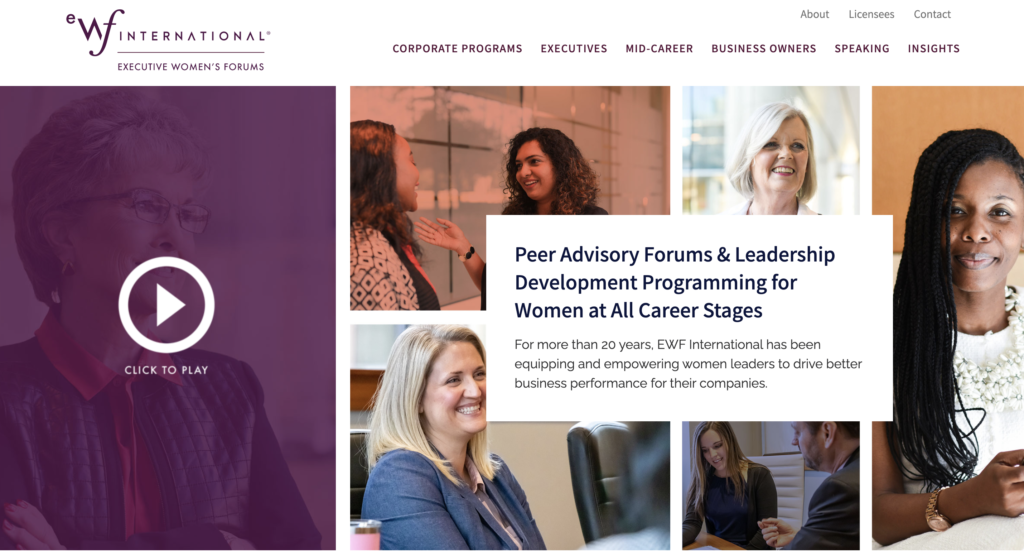Creating a new website for your B2B business can seem like an overwhelming task. It might sound easier to hire a developer and wash your hands of the whole process. While we believe there is wisdom in allowing experts to act in your best interest, having a foundational understanding of B2B web development can help you gauge the quality and effectiveness of your developer’s work.
B2B web development can be an exciting, personal, and enlightening project for your company and its staff. Are you considering a website refresh for your current site or a new website built from the ground up? Before reaching out to a B2B web developer, we have some points for you to consider.
Start with a Website Audit
If you already have a website, take a hard look at everything that’s on it. How is the site laid out? Is it easy to navigate?
There may be key information that is missing. Ask your customer-facing staff what frequently asked questions they receive that are unanswered by the website. Investigating these questions can lead to insights about your website content that is absent or difficult to find.
After a cursory review of your website content, dig deep into your B2B website’s analytics. Your website’s analytics will help create benchmarks for you to measure improvements in your website. What’s more, analytics can reveal problem areas of the website. For example, a page with high traffic volume and a 90%+ bounce rate likely indicates a disconnect in the page’s content and the visitors’ expectations. It might not be doing the right job. Are users frequently exiting from landing pages without converting? Layout, call-to-actions, or the content offer could be the culprit.
Make a note of improvement areas and benchmark analytics data before diving into planning a new website strategy.
New B2B Web Development Starts with Strategy
“It takes about 50 milliseconds (that’s 0.05 seconds) for users to form an opinion about your website that determines whether they like your site or not, whether they’ll stay or leave.“
Taylor Francis Research Journal
Imagine your target audience for a moment. Who are they, what are their job responsibilities, what do they want, and what do they need? Every element of your B2B website, from design and structure to on-page content, should be serving your audience and meeting them where they are in the buyer’s journey.
Use the Buyer’s Journey to Guide Your B2B Website Strategy
The buyer’s journey is a helpful framework for creating a website that nurtures your target audience at every level of their interest and engagement. It’s broken up into four stages:
- Awareness – When your audience is just beginning to define their problem, your goal is to make them aware of your company and potential solutions to their problem. This goal is achieved by providing information and answering questions.
- Consideration – After defining their problem, your audience begins to consider solutions, and you want them to consider your offerings. Compelling offers and case studies are great ways to stay on their mind.
- Conversion – Now, you need to convince your audience to choose you over the competition. Making the conversion is a combination of nurturing your audience, demonstrating your expertise, and providing social proof in client reviews and testimonials to show your audience they’re making the right decision.
- Support – Your job isn’t done when they’ve converted. Keeping customers happy means providing them with consistent stellar support, and your website should be a tremendous asset during this stage.
You don’t need to be a marketing pro to plan for a B2B website design that handles all of these considerations. We’ve put together a list of questions to guide your website roadmap.
Who is Your Ideal Audience
Before creating any assets, clarify your target audience. Understand their pains, desires, and preferences.
Who Should You Target and Avoid
Buyer Persona exercises are an excellent tactic for developing a clear vision of the people who are your ideal clients. Just because you’re a B2B company doesn’t mean you don’t need to consider the personal aspects of your audience. They’re real people with preferences, ideas, hopes, dreams, and fears. “Anti-personas” are another helpful exercise; answer all the same persona questions, but for the audience, you do not want.
How Does Your Audience Research
You want to meet your audience where they are. If they use Google to research and ask questions, you will need a great SEO strategy and content marketing plan to ensure they find you first and not the competition.
What Does Your Audience Want
All B2B websites are not created equal. Your business offerings should be served directly by your website. Depending on your offerings and audience, your website focus may be lead generation, eCommerce sales, educating and informing your audience, or any combination of the above.
What Do You Offer Your Audience
Having a clear answer to this question is necessary for everything in B2B web development, from brand design standards to site hierarchy to the content you should add to your website.
How Do You Intend Your Audience to Use the Website
Is your audience coming to your website seeking information before reaching out to you? Do they need a place to submit an RFP? Or do they want to make a purchase directly from an online store?
Often, there are multiple avenues for conversion on your website. Outlining these conversion paths in advance brings clarity to the site structure of your B2B website.
As important is how you are going to manage and provide for all of these needs efficiently? Well-organized and integrated back-end and front-end solutions will be required for managing and optimizing this audience flow.
What Offering Information Does Your Audience Need
“If you only had 4 seconds to tell your audience about your offer, what would you tell them?”
Focus on your value proposition and what makes your offerings relevant and unique. Turn your answer into content to present front-and-center on your website. When in doubt, remember the best B2B websites are client-centric. Focus on them, how they will benefit, and how you have already helped people just like them.
Develop Clear and Valuable CTAs
All your website information and great content are for naught if you don’t give website visitors a clear, actionable next step to take. Clear, persuasive CTAs mapped to the right stage of the buyer’s journey make all the difference for your conversion rates. We’re talking about the difference between 50% and 0.01% conversion rates.
Use the buyer’s journey as a guide for your internal linking and CTAs. If a page is mainly for visitors in the Awareness stage, links to your service pages, about us, and blog pages are a good fit. Conversion-stage landing pages should be all about encouraging the next step; for B2B, this is often scheduling a demo, signing up for a trial, or contacting a salesperson.
Bonus Tip
Active voice, actionable CTAs consistently convert best. Start your CTA button and link text with action verbs like Discover, Learn, and Get.
Keep Your B2B Web Development Streamlined, Trim Website Fat
When focusing on your prospective clients and their needs as the guide for developing your website, it’s essential to remove all distractions. The difference between a good website and a great website is focus and brevity. If an element of your website does not lend itself to the ideal website experience you’ve defined, remove it.

EWF International offers leadership and career development resources for women. They came to Bold Entity for a complete B2B web development package; we helped them with everything from brand standards and a new website to digital marketing execution. Bold Entity and EWF International carefully considered each website element in the pursuit of creating an engaging, informative website that empowers women in their professional development.
Custom Website Development vs. WordPress
WordPress is omnipresent on the modern web. The world’s juggernaut Content Management System, WordPress hosts an estimated 40% of all websites on the internet. But that begs the question, what about the other 60%? While the most common CMS, WordPress is not great for every application.
Consider Your Plan for Website Updates
WordPress CMS makes internal updates more straightforward to manage than most proprietary website development avenues. How much control over your website internally? Does your team need a front-end page builder or specific plugins for SEO, CRM, or leads management? WordPress offers many simple solutions for these applications, while custom-built websites might require additional development expertise to integrate and handle these challenges.
Still, some websites require more than WordPress offers. There are other CMS available, and in general, you will want aCMS for managing your B2B website. Not having a CMS for your website means reaching out to your developer every time you want to make a website change.
CMS & Web Hosting Technical Requirements
On the topic of CMS solutions, will you have internal developers working on the website? Will they have a specific preference for a CMS? The content team isn’t the only player in the modern CMS game. If you offer software or cloud-based offerings directly to visitors or consumers through your website, a developer-friendly or custom CMS might be the best solution.
What about website hosting? Your server space needs and the technical requirements of your website will influence the complexity of the web hosting you need.
If a developer requires you to host a website through them, turn and run. Demanding control over your hosting is sometimes a manipulation tactic used by unscrupulous web developers. It exposes you to the risk of a website ransom. These developers charge a monthly hosting fee, and if a client attempts to leave the developer, they threaten to take down or delete the website.
It’s unlikely, but in our view, no developer worth their salt should expose their clients to this risk in the first place.
Lastly, remember the Caveat Emptor; you often get what you pay for with website developers. Websites turned out quickly with a standard WordPress theme for a low price have an increased likelihood for technical hiccups, security risks, and unexpected costly fixes.
The development and continued support of your B2B website is not the place in your budget where it pays to be overly cost-conscious.
B2B Web Development Considerations
Mobile vs. Desktop Traffic
Is your traffic primarily using mobile or desktop devices to find your website? Knowing the devices your audience use to navigate your site is critical to a successful website design. Check your website analytics. Unlike B2C, many B2B websites still have a mobile-desktop traffic ratio in favor of desktops, despite the universal adoption of smartphones.
If 70% or more of your current website traffic is mobile, using a “mobile-first” design philosophy will pay you back in spades. More and more B2B traffic is moving toward mobile-first searches, and the trend shows no signs of slowing down.
Get to the Point Fast
In a matter of milliseconds (remember, 50 milliseconds to be exact), a visitor should know who you are, what you offer, and if it will work for them. Achieving that specific message takes some careful planning for website titles, headings, and layout. Every element on your web pages should lend itself to communicating this message.
Resources for Top-of-the-Funnel B2B Buyers
Website visitors in the awareness stage of the buyer’s journey will comprise the vast majority of your target audience. Primarily they are seeking education, troubleshooting, and Q&A-style content. Resource sections offer the best place for them to gain basic, free information without filling out a form or contacting a salesperson.
Emphasize Easy Navigation
A good rule of thumb to follow is: someone who lands on your website should be able to find what they need in under 30 seconds, often stated as the 3-Click-Rule. The idea being visitors should be able to find what they need in three clicks or less.
If navigating where they want to be is difficult or confusing, you won’t get a second chance. The modern web visitor will abandon a confusing site and look somewhere else.
Make a Data Collection and Information Management Plan
The conversions you’re driving have to go somewhere. Your form fills, signups, and RFQs need to find the proper team members so they can act. If you’re taking payments, you’ll also need a secure method for managing customer payment information. Nothing destroys a company’s good reputation like a preventable leak of sensitive data.
Social Proof is the #1 Credibility Builder
Humans are social creatures, and nothing tells a compelling story to your visitors like social proof. Case studies, testimonials, reviews, professional associations, awards, and any evidence demonstrating your company’s expertise is vital. Video testimonials are an excellent way to stand out and offer a medium for storytelling that written quotes can’t match.
Keep Clients Happy with Support Features
If a website visitor or existing customer takes the time to reach out to you to ask a question, you want to be able to get back to them promptly with exactly what they need. Website chatbots are a great way to provide this solution without calling or submitting a contact request. If you do set up separate contact forms or phone lines, make sure they’re easy to find and closely monitored.
International B2B Websites Must Abide the GDPR
The EU passed the strictest privacy-focused legislation in internet history with the GDPR in 2018. If you’re serving EU visitors or could be serving them, you’ll want to toe the line with your privacy policy and data collection. Violations can cost companies thousands or even millions of dollars.
Improving Your Website After Launch
The website launch date is a rightly celebrated occasion, and your team can breathe a well-earned sigh of relief. Of course, like most things in marketing and business, a job well done is never truly finished.
Measuring and Adjusting to Improve KPIs
Excellent analytics tracking is imperative to making incremental improvements to your website. Conversion Rate Optimization will rely on a clear understanding of the website conversion paths you outlined at the beginning of your planning. Review bounce rates and track successful events at every step on your paths to identify bottlenecks in your conversion flow.
Search Engine Optimization will also rely heavily on your measurement of website metrics and KPIs. Ideally, every indexed page on your website will have a place in your SEO strategy, from generating traffic and leads to supporting website authority and context. Using analytics tracking to monitor your position in Search Engine Results Pages and website engagement will give you insight into tweaking your SEO strategy to increase your website traffic.
Monitor Marketing Progress Across All Channels
Ultimately, all these tactics work toward the same goal: to increase your online visibility and drive high-quality traffic to your website for conversion. Developing a cohesive digital marketing strategy makes evaluating all the elements of your website through the lens of your key performance metrics manageable. Your marketing strategy should function like a well-oiled machine, with a complete and clear understanding of all your website’s aspects, without any loose ends.
If you’re looking for B2B web development assistance, look no further than Bold Entity. We’re experts at building out the systems and structure to launch your website to the forefront of your industry. We can help you with updates, developing a new website, and supporting your website with a digital marketing strategy to help you drive high-quality traffic to your website. Shoot us a message right now to claim a free consultation call.








